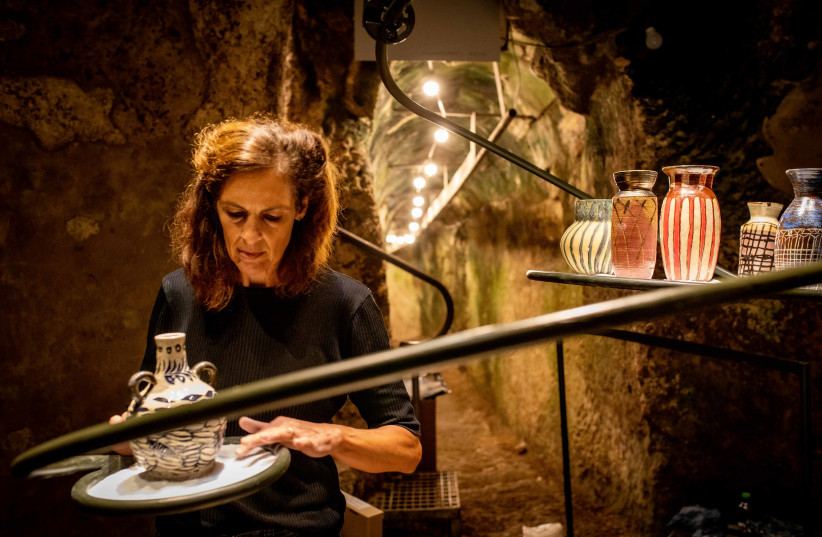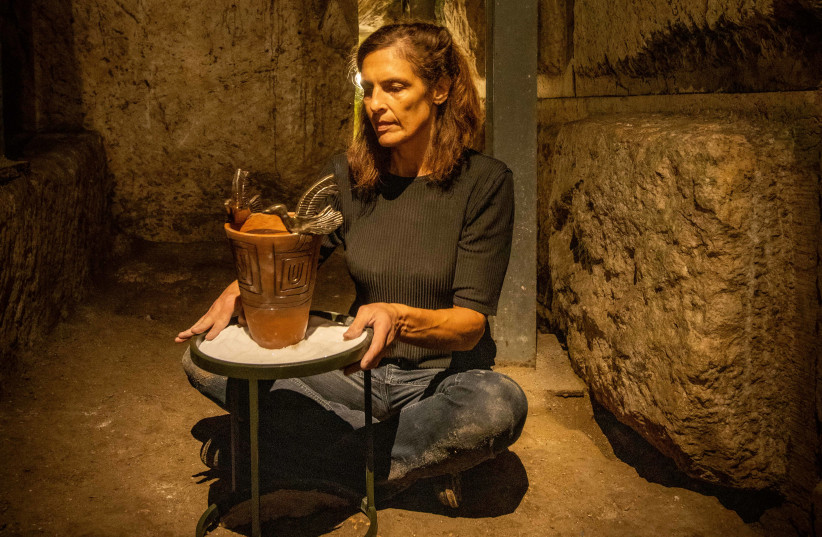When is the last time you climbed down steep metal steps into a 2,700-year-old water system to look at contemporary art? If you can make it to Jerusalem’s Old City by Friday, you can see Arteology, an exhibit of 27 ceramic pieces by Canadian-born artist Nicole Kornberg-Jacobovici in a water cistern that sits under the southern corner of the Western Wall.
“By placing it in an active archaeological site where people wouldn’t at all go to see contemporary art, it's bringing life into an ancient space,” Kornberg-Jacobovici told The Jerusalem Post.
“Clay and art are about the space you create, the space of the sculpture and the space around it. Clay has an energy and a spirit of its own. Locating it in a place that has an ancient holy history is giving it a place to experience it differently.”
The ceramic pieces are arranged on a metal display stand and are based on her research of ancient cultures. Several have a biblical theme, including a vase that she says is inspired by the story of Jonah and the whale. The colors of her pieces are beautiful with deep blues and browns.
Archaeologist Yuval Baruch, the head of the Jerusalem District for the Israel Antiquities Authority, says it’s the first time that Jerusalem has had an art exhibit in an active archaeological site although it has been done in other places around the world.

“This is not the first time that art and ruins are combined,” he told a small group of journalists in advance of the exhibit’s opening. “But most of the time it means using video art or virtual reality to present the ruins. We don’t need to do that because we have the ruins in front of our eyes. But we wanted Nicole to bring her interpretation of what Jerusalem does in our imagination.”
Where you can see the exhibit
During the Sukkot holiday, thousands of Jewish pilgrims walk through a tunnel from the City of David to the Davidson Center next to the Western Wall. The exhibit is in a water cistern that dates back 2,700 years, according to Baruch. Only 20 people can enter at a time, and the artist is on hand to explain her pieces. There is no extra charge to see the exhibit.
The exhibit is curated by art historian Irit Zeffer and is being presented as part of the Jerusalem Biennale, an art festival that occurs every other year.
“Clay is a basic and available and cheap material,” Zeffer said. “Man first used clay to make figurines and then discovered it could be made in a fire into a hard material that is waterproof/ He began to use clay for containers for liquids to store his grain or other food.”
Clay was also used for seals, and one of the pieces in the exhibit is a seal carved with images from Joseph’s dreams.
In a separate area next to the cistern are several pieces in which Kornberg-Jacobovici used different clays and different firing techniques including electric, raku, grill and obvara. These look older than the more modern pieces in the main exhibit.
The exhibit is only available for three days, but the artist and curator hope it will then go around the world. There has already been an interest in showing the exhibit in Rome, Athens and Tokyo as well as Kornberg-Jacobovici’s native Canada.

While the setting is an ancient cistern, the art itself is contemporary and fits the theme of the Jerusalem Biennale, says director Rami Ozeri. An observant Jew with a black kippah, Ozeri says he wasn’t supposed to be working this Sukkot as the Biennale happens every other year. But the opportunity to work with the exhibit was too good to pass up, he said.
“Art in Jerusalem is always site-specific,” he said. “We have this amazing opportunity to connect the magnificent ceramic art by Nicole with the foundations of the most important ancient structure of this part of the world. This connection is magical both aesthetically and symbolically.”
